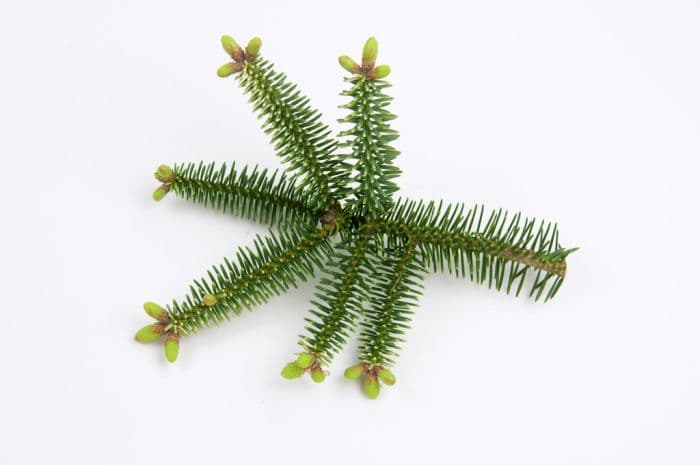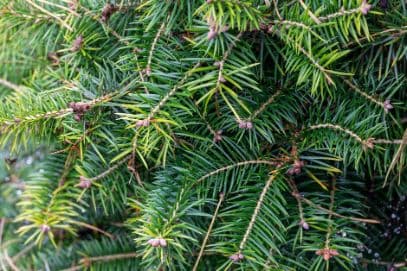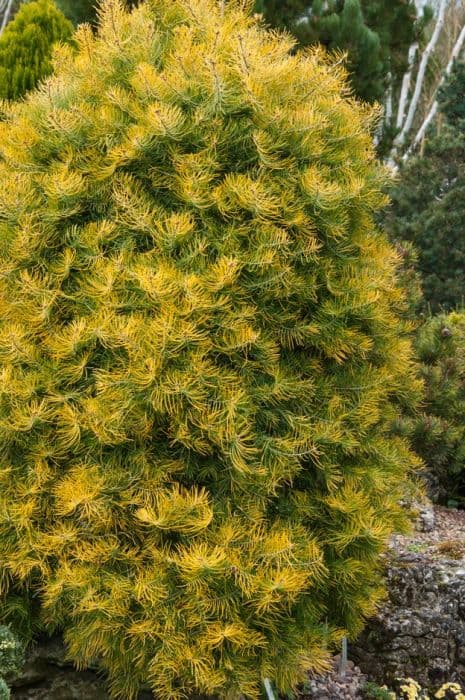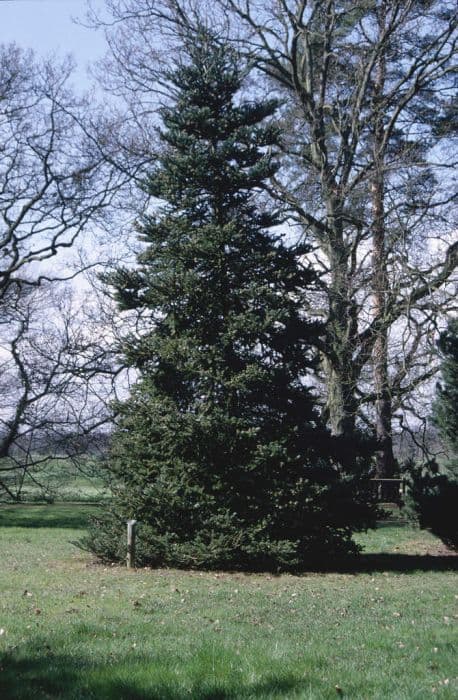Golden Spanish Fir Abies pinsapo 'Aurea'

ABOUT
The Golden Spanish Fir, known for its distinctive look, is a coniferous tree with a lush, dense habit. Its needles are particularly striking, displaying a brilliant yellow-gold hue that truly sets it apart. These needles, which are short and arranged in a radial pattern around the branches, create a stunning contrast against the darker, green hues commonly found in conifer forests. The bark of this tree adds to its aesthetic appeal with a grayish-brown color that is both textured and rugged. As a cultivar of the Spanish Fir, the Golden Spanish Fir’s branches grow in a whorled fashion, contributing to its symmetrical and conical shape. This appearance is further enhanced in the spring when new growth emerges, giving a brighter inflection of color to the tree. Additionally, during the cooler months, the tree maintains its allure as the golden needles persist, albeit potentially with a slightly duller tone. The positioning of the needles on the branches exaggerates the tree's overall golden appearance, especially when it catches the sunlight, creating a shimmering effect. The tree also produces cones, which are upright and cylindrical, adding another dimension to its visual interest. These cones typically exhibit a green color when young, transitioning to a more brownish tone as they mature and become woody. Overall, the Golden Spanish Fir is a visually striking tree that can provide year-round color and interest with its brilliant golden needles and elegant form.
About this plant
 Names
NamesFamily
Pinaceae
Synonyms
Golden Spanish Fir, Aurea Spanish Fir
Common names
Abies pinsapo 'Aurea'.
 Toxicity
ToxicityTo humans
The Spanish Fir (Abies pinsapo 'Aurea') is not commonly known as a toxic plant to humans. Generally, fir trees are not considered poisonous, and there are typically no serious symptoms associated with ingesting parts of this plant. However, it's always a good idea to avoid eating parts of ornamental plants due to potential gastrointestinal discomfort or allergic reactions.
To pets
The Spanish Fir (Abies pinsapo 'Aurea') is also not known to be toxic to pets. While pets should not be encouraged to chew or ingest parts of this plant, as it can potentially cause mild gastrointestinal upset, there is no severe toxicity reported for dogs or cats consuming this type of fir.
 Characteristics
CharacteristicsLife cycle
Perennials
Foliage type
Evergreen
Color of leaves
Golden
Height
30 feet (9 meters)
Spread
20 feet (6 meters)
Plant type
Tree
Hardiness zones
7
Native area
Spain
Benefits
 General Benefits
General Benefits- Aesthetic Appeal: The Spanish fir adds visual interest to landscapes with its unique golden-yellow foliage and conical shape.
- Evergreen Nature: It maintains its needles year-round, providing constant greenery even in winter months.
- Drought Tolerance: Once established, the Spanish fir can tolerate dry conditions, making it suitable for areas with water restrictions.
- Low Maintenance: It requires minimal care beyond the initial planting and occasional watering during dry periods.
- Cold Resistance: The Spanish fir is resilient in cold climates, making it a good choice for northern gardens.
- Suitable for Wildlife: The tree provides habitat and shelter for various bird species, enhancing local biodiversity.
- Non-Invasive Roots: Its root system is not known to be invasive, reducing the risk of damage to nearby structures and hardscapes.
 Medical Properties
Medical PropertiesThis plant is not used for medical purposes.
 Air-purifying Qualities
Air-purifying QualitiesThis plant is not specifically known for air purifying qualities.
 Other Uses
Other Uses- In woodworking, the wood of the Spanish fir can be used for decorative veneers or inlay work due to its fine grain and aesthetic appeal.
- As a habitat, it provides shelter and nesting sites for various species of birds and small mammals, which find refuge in its dense branches.
- This fir can be used as a windbreak or a privacy screen in large gardens and parks because of its conical shape and dense foliage.
- The tree sap can be used as a natural adhesive or resin in certain traditional crafting techniques.
- In photography and film, the distinctive golden hue of 'Aurea' offers a unique backdrop for outdoor shoots, especially in golden hour light.
- The cones of the Spanish fir can be collected and utilized in decorative arts and crafts, providing a natural and rustic element to designs.
- For educational purposes, this plant serves as an excellent example in botany and horticulture classes for teaching about gymnosperms and conifer growth habits.
- Cultural significance might be found in certain communities where the Spanish fir is a symbol or emblem and used during festive ceremonies or local traditions.
- The boughs and needles can be used in the creation of fragrant wreaths and garlands for seasonal decor.
- In landscape photography workshops, the tree can serve as a subject for teaching techniques like lighting and composition due to its striking appearance.
Interesting Facts
 Feng Shui
Feng ShuiThe Spanish Fir is not used in Feng Shui practice.
 Zodiac Sign Compitability
Zodiac Sign CompitabilityThe Spanish Fir is not used in astrology practice.
 Plant Symbolism
Plant Symbolism- Endurance and Longevity: Abies pinsapo 'Aurea', or the Spanish Fir, is an evergreen tree, which often symbolizes the enduring aspect of nature, surviving and remaining green throughout the seasons, representing the ability to withstand hardships and time.
- Rarity and Uniqueness: The 'Aurea' cultivar, with its distinct golden-hued needles, is relatively rare and sought after. This uniqueness can symbolize exclusivity or a precious quality in symbolic contexts, much like a golden treasure.
- Growth and Stability: As a tree with a strong root system, the Spanish Fir may represent growth, both personal and spiritual, and the stability necessary to sustain it. Trees often embody the growth from a small seed to a strong structure.
- Sanctuary and Peace: Trees are commonly seen as sanctuaries for wildlife, offering shelter and food. The Spanish Fir's evergreen canopy may thus be a symbol of peace and a safe haven.
- Resilience: Adapted to high altitudes and rocky soils, the Spanish Fir showcases resilience and the ability to thrive in less-than-ideal conditions, signifying overcoming of challenges or adversity.
 Water
WaterThe Spanish Fir or Golden Spanish Fir should be watered deeply and infrequently to mimic its natural habitat, generally about once a week during active growth in the spring and summer. Adjustments should be made for rainfall, with less water required during wet periods. In the fall and winter, watering can be reduced to every two to three weeks depending on weather conditions. Each watering session should consist of about 1 to 2 gallons of water for young trees, ensuring that the soil is moist but not waterlogged. Mature trees will often require more water but less frequently, benefiting from deep watering that promotes a strong, deep root system.
 Light
LightThe Golden Spanish Fir thrives best with exposure to full sun to partial shade. It prefers a location where it can receive at least six hours of direct sunlight each day, though it can tolerate some light afternoon shade. Avoid deeply shaded spots as inadequate light can stunt growth and affect the overall health of the tree.
 Temperature
TemperatureGolden Spanish Firs are hardy and can withstand a range of temperatures but grow best when daytime temperatures are between 60 to 75 degrees Fahrenheit. They can survive in temperatures as low as 0 degrees Fahrenheit once established. However, they are not suited for extremely hot climates as prolonged temperatures above 80 degrees Fahrenheit can stress the tree.
 Pruning
PruningPruning of the Golden Spanish Fir is generally minimal and should focus on removing dead or damaged branches to maintain plant health. The best time for pruning is in the late winter or early spring before new growth begins. Light shaping can be done at this time if necessary, although the tree's natural conical shape usually requires little intervention.
 Cleaning
CleaningNot needed
 Soil
SoilThe Golden Spanish Fir requires well-draining, acidic to neutral soil, with an ideal pH range of 5.5 to 7. The best soil mix for the Golden Spanish Fir is one part peat, one part pine bark, and one part coarse sand or perlite, ensuring good aeration and drainage.
 Repotting
RepottingGolden Spanish Firs are slow-growing trees which typically need repotting every 3 to 5 years. They should be repotted in the spring before new growth starts, using the previously recommended soil mix.
 Humidity & Misting
Humidity & MistingThe Golden Spanish Fir prefers moderate to high humidity levels. It thrives best in an outdoor environment where natural humidity is sufficient, and generally does not require additional humidity control.
 Suitable locations
Suitable locationsIndoor
Not ideal indoors, needs full sun and space.
Outdoor
In full sun, well-drained soil, protected from hot winds.
Hardiness zone
6-8 USDA
 Life cycle
Life cycleThe Abies pinsapo 'Aurea', commonly known as the Golden Spanish Fir, begins its life as a seed, usually germinating in the spring following a period of cold stratification which breaks dormancy. After germination, the seedling undergoes a period of growth, developing a taproot and foliage in a juvenile stage. Over several years, the sapling matures into an adult tree, characterized by a conical shape, with branches that grow horizontally and foliage that turns a golden-yellow color in the sunlight. The tree reaches reproductive maturity, producing male and female cones; the female cones are positioned upright and release seeds when they mature. The seeds are dispersed by wind, and those that land in suitable environments will germinate to begin a new life cycle. The Golden Spanish Fir has a long lifespan, potentially living for several centuries and continuing to grow in height and girth throughout its life.
 Propogation
PropogationPropogation time
Spring-Early Summer
The golden Spanish fir, scientifically known as Abies pinsapo 'Aurea', is generally propagated through seed sowing. The best time to sow seeds is in the fall or early spring. To ensure a successful propagation, stratification, which is a cold treatment, is typically required before sowing to break the seed dormancy. The seeds should be kept at a temperature of around 34-41 degrees Fahrenheit (1-5 degrees Celsius) for approximately a month. After stratification, seeds are sown in a well-draining soil mix and are lightly covered with soil. The seedbed needs to be kept moist but not waterlogged, and the germination can take several weeks. Care should be taken to protect the seedlings from extreme temperatures and drying winds.









